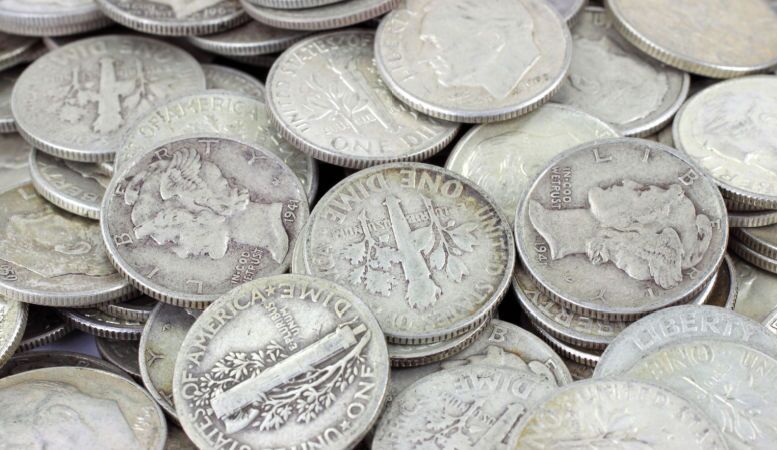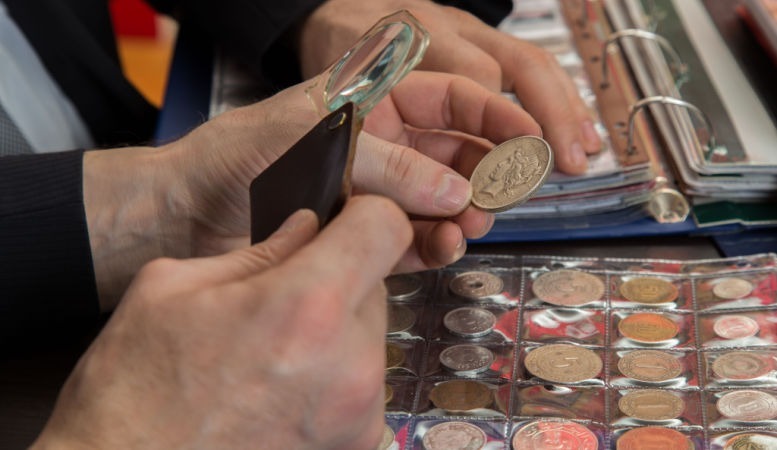Table of Contents
Whether you are an avid coin collector or a history buff, silver dimes provide incredible value.
Dimes were the first U.S.-minted coins. In 1792, George Washington made the initial order for silver dimes. While they consisted of 90% silver for a while, the Coinage Act called for all coins to have base metals of nickel and copper by 1965.
Determining dime values requires a keen eye and knowledge of silver price, coin condition, and other factors. Keep reading as our team at The Oxford Gold Group explains everything about estimating silver dime value.
How Much Is a Historic Silver Dime Worth Today?
Due to their variety, silver coins have become a popular collector’s commodity. From condition to color, a dime’s value differs with each coin. Generally, rare coins exhibit the highest value.
Older dimes minted before 1965, now called junk silver, typically consists of 90% silver, making them significantly more valuable than newer coins with a base metal of copper and nickel alloy. Generally, older silver coins are worth more than 13,800% of the value of modern copper-and-nickel-based dimes.
How To Calculate the Value of a Silver Dime Using Troy Ounces
While coin values will vary dramatically, you can use this simple equation to calculate the typical silver melt value of a coin:
Silver dime worth in silver melt value = (0.0723 ounce) x (current silver spot price)
For instance, let’s say the silver spot price is $19.35. To calculate the silver dime melt value, you would perform the following calculation:
$19.35 x 0.0723 troy ounce silver content = silver dime melt value of $1.39.
The Most Valuable Silver Dimes

The following are the most valuable junk silver coins.
Seated Liberty Dime
The Seated Liberty Dime dates back to President Andrew Jackson. Following the War of 1812, President Jackson helped America achieve economic prosperity and pushed the Seated Liberty Coin into circulation.
Today, you can expect your Seated Liberty Dime to have the following values:
- 1873-CC (without arrows): $1,276,778
- 1871-CC: $118,793
- 1872-CC: $116,951
- 1874-CC: $70,691
- 1873-CC: $70,690
- 1846: $41,704
- 1843-O: $38,100
- 1859-S: $27,963
- 1858-S: $17,172
- 1856-S: $16,636
- 1860-O: $16,363
- 1865-S: $13,242
- 1844: $13,240
- 1885-S: $9,866
- 1839-O (reverse of 1838 Seated Liberty dime): $9,911
Silver Roosevelt Dimes
The silver Roosevelt Dime is one of the most valuable silver coins in the United States. After President Franklin D. Roosevelt’s death in 1945, the U.S. Treasury Department commemorated him by changing the dime’s design to display Roosevelt’s portrait, hence the name silver “Roosevelt Dime.”
The following prices for particular mintings of silver Roosevelt Dimes are the typical purchase values for an uncirculated silver Roosevelt Dime based on the mint year and mark, with 90% silver:
- 1968 silver Roosevelt Dime with no-S: $10,000
- 1970 silver Roosevelt Dime with no-S: $450
- 1975 silver Roosevelt Dime with no-S: $300,000
- 1982 silver Roosevelt Dime with no-P: $125
- 1983 silver Roosevelt Dime with no-S: $500
Draped Bust Dimes
Created in 1796, the Draped Bust Dime’s design faced controversy when people complained that the eagle on the coin was too skinny. In response to the widespread criticism, the coin’s original designer, Robert Scot, released a new design featuring a simplified version of the U.S. Great Seal.
The obverse side shows Lady Liberty with her hair tied in a ribbon. On her left side are seven to nine stars, with six to seven stars on her right.
The face value of a Draped Bust Dime per mint year is as follows, with 90% silver content:
- 1804 (14 stars): $64,178
- 1797 (13 stars): $871635
- 1798 (eight over 7 to 13 stars): $77,380
- 1804 (13 stars): $66,705
- 1802: $59,027
- 1797 (16 stars): $52,391
- 1801: $51,950
- 1800: $44,899
- 1798 (small 8): $44,448
- 1796: $44,448
- 1805 (five berries): $21,883
- 1798 (eight over 7 to 16 stars): $21,882
- 1805 (four berries): $15,510
- 1807: $13,562
Capped Bust Dimes

The Capped Bust Dime is the first American coin to display its face value numerically. It features Lady Liberty in a robe on the obverse side. To her left are seven hexagram stars and to her right are six, representing the 13 colonies.
The reverse side has an image of an eagle holding three arrows and an olive branch. Beneath the eagle’s talons is the coin’s total face value reading “10 C.”
The following are the values of Capped Bust Dimes dating from 1796 to 2021:
- 1829 (curl base 2): $48,377
- 1822: $27,957
- 1824 (4 over 2- pointed top 1): $20,024
- 1809: $7,852
- 1811 (11 over 09): $6,948
- 1829 (extra-large “10 C”): $6,522
- 1828 (large date- curl base 2): $6,075
- 1820 (“StatesOfAmerica”): $5,566
- 1814 (“StatesOfAmerica”): $5,566
- 1814 (small date): $5,566
Mercury Dimes
The Mercury Dime is one of America’s most distinctive silver coins. On the obverse side, it has Lady Liberty in a winged Phrygian cap. To her left side are the words “In God We Trust,” while “Liberty” circles her profile.
On the other side of a Mercury Dime is an image of a bundle of wood and rods over an olive branch, representing strength, unity, and peace. It also has “One Dime” stamped on the bottom and “United States of America” on the top.
Mercury Dime values with 90% silver and San Francisco, Philadelphia, or Denver minting are as follows:
- 1916-D: $31,006
- 1942 (42 over 41): $16,643
- 1942-D (42 over 41): $10,220
- 1921-D: $3,887
- 1921: $3,779
- 1826-S: $3,115
Barber Dimes
The U.S. minted Barber Dimes from 1892 to 1916. Like other junk silver dimes, the obverse side displays Lady Liberty. The coin date sits below her.
The coin gets its name from its designer, Charles E. Barber. Today’s values are as follows per mint year with 90% silver:
- 1905-O (micro-O): $3,779
- 1894-O: $2,745
- 1896-O: $2,581
- 1893 (3 over 2): $135
- 1895-O: $350
- 1894-S: $1,000,000
What To Look Out for When Inspecting a Silver Dime

Determining the silver value of coins, whether a dime or a half dollar, requires careful attention and knowledge of what to look for. Aside from silver content, you should also look for the following when estimating junk silver coin values:
Coin Series
When inspecting a dime, it is important to consider its series or rarity. U.S. dimes come in numerous design series spanning decades. In addition, some dime designs are rarer than others, impacting their selling price and overall value.
Mint Marks and Dates
When determining a silver dime’s worth, be sure to look for the mint mark. For example, The United States Mint used three different mint marks: S (San Francisco), D (Denver), or no mark or “P” (Philadelphia). You can find the mint mark on the side that says, “ONE DIME,” just above the “E.”
Similarly, some coins will have privy marks of “O” or “CC.”
Grading Wear
The grading process impacts the look and wear of a coin, thus affecting prices. A thorough inspection of the coin will tell you the grading condition and overall preservation quality.
Unique Qualities
The price of a collectable coin can vary depending on the coin’s unique qualities. This can include bullion value and scarcity.
Bullion vs. Collector Dimes
Precious metal investors often wonder: What is the difference between bullion and collector dimes?
Collector dimes tend to have more historical value.
Bullion consists of precious metals created for the sole purpose of investment. Silver bullion comes in three forms:
- Coins
- Bars
- Rounds
Since silver bullion coins are only for investments, as they cannot serve as traditional currency. Precious metals are a popular investment because they hold their value during times of economic or social upheaval, thus being a safe haven investment.
Bullion and collector’s coins typically contain the same ratio of silver, making them similarly priced when comparing troy ounces.
How Do You Grade Silver Dimes?

Grading silver coins can seem challenging initially. Fortunately, it is not an exact science.
Grading coins requires using the Sheldon Scale, which ranges from P-1 (poor) to MS-70 (mint state condition). After familiarizing yourself with this scale, follow these steps to grade your dime:
- Ensure that you have proper lighting and a 5x to 8x magnifying glass.
- Determine if your coin is uncirculated (mint state), in extremely fine condition (has some signs of wear), or circulated.
- Use the Sheldon Scale to determine the grade, paying close attention to details and overall wear.
How to Store Roosevelt Dimes and Silver Coins
Whether you have a silver dime, a half dollar, or a quarter dollar, it’s essential to know how to store your coins. To protect your investment, follow these steps to ensure proper silver storage:
- Store them somewhere dry and cool to prevent humidity and water damage.
- Keep them away from abrasive substances like paper, PVC plastics, and aluminum foil.
- Put your dimes, quarter dollar, and half dollar coins in an airtight container to prevent tarnishing.
Buy Your Next Roosevelt, Seated Liberty, or Mercury Dime From the Oxford Gold Group
Purchasing Seated Liberty Dimes, Roosevelt Dimes, and other collectable coins is a great way to collect pure silver without spending a fortune on precious metals.
Silver dimes make worthwhile investments that boast historical value and beautiful designs. Whether you want to purchase a mint-state Roosevelt dime or compare prices for Seated Liberty coins, our team at The Oxford Gold Group is here to help.
We will fully insure your purchase, protecting what you pay for with the utmost professionalism.
Contact us today at (833) 600-4653 to learn more about how to pay the right amount to invest in pure silver through historic and beautiful coins.








